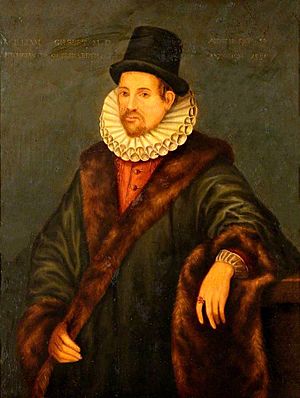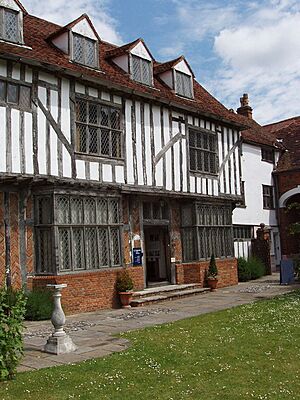William Gilbert (physician) facts for kids
Quick facts for kids
William Gilbert
|
|
|---|---|

William Gilbert
|
|
| Born | 24 May 1544 |
| Died | 30 November 1603 (aged 59) London, England
|
| Nationality | English |
| Education | St John's College, Cambridge (MD, 1569) |
| Known for | Studies of magnetism, De Magnete |
| Scientific career | |
| Fields | Physician |
| Influences | Leonardo Garzoni, Giambattista della Porta |
William Gilbert (24 May 1544? – 30 November 1603) was an English doctor and scientist. He is also known as Gilberd. He did not agree with the old ways of teaching science at universities. Gilbert is best known for his book De Magnete, published in 1600.
A unit used to measure magnetic force is named the Gilbert in his honor.
Contents
Who Was William Gilbert?
William Gilbert was born in Colchester, England. His father, Jerome Gilberd, was a local judge. Gilbert went to St John's College, Cambridge for his education.
In 1569, he earned his degree as a doctor. After a short time working at his college, he moved to London. There, he started practicing medicine. He also traveled around Europe.
In 1573, he became a member of the Royal College of Physicians. He was later chosen to be the President of the college in 1600. From 1601 until her death in 1603, he was the personal doctor to Queen Elizabeth I. The next king, King James I, also kept him as his doctor.
Discoveries About Magnetism
Gilbert's most important scientific work was his book, De Magnete, Magneticisque Corporibus, et de Magno Magnete Tellure. This long title means On the Magnet and Magnetic Bodies, and on the Great Magnet the Earth. He published it in 1600.
In this book, he wrote about many experiments. He used a small, round magnet that looked like Earth. He called this model the terrella. From his experiments, Gilbert figured out that Earth itself was a giant magnet. This explained why a compass always points north. Before this, some people thought a star or a magnetic island pulled the compass needle.
Gilbert was also the first to say that the center of the Earth was made of iron. He also found that if you cut a magnet, each new piece becomes a magnet with its own north and south poles.
Earth's Daily Spin
In his book, Gilbert also talked about Earth's daily spin. He said it made more sense for the smaller Earth to spin each day. He thought it was silly to believe that huge celestial spheres (which he doubted even existed) rotated daily. He also believed that the "fixed" stars were at different distances from Earth. They were not stuck to an imaginary sphere.
Understanding Electricity
The English word "electricity" was first used in 1646. It came from Gilbert's Latin word electricus. This word meant "like amber". Amber is a fossilized tree resin. When you rub amber, it can attract light objects.
Gilbert was the first to use this word to describe things that attract other objects when rubbed. He thought that rubbing these objects released a special "effluvium." This invisible substance would then cause the attraction. He did not know that this "electric charge" was present in all materials.
Gilbert also studied static electricity using amber. The Greek word for amber is elektron. This is why Gilbert called the attraction effect the electric force. He also invented the first tool to measure electricity. It was a needle that could pivot, and he called it the versorium.
Magnets and Electricity Are Different
Gilbert believed that electricity and magnetism were not the same thing. He pointed out that heat made electrical attraction disappear. But he thought magnetic attraction did not disappear with heat. (We now know that strong heat can weaken magnets.)
Later, scientists like Hans Christian Ørsted and James Clerk Maxwell showed that electricity and magnetism are actually parts of one force: electromagnetism.
Mapping the Moon
In the 1590s, Gilbert tried to map the surface of the Moon. He did this without a telescope. His map showed dark and light areas on the Moon. Unlike many people at the time, Gilbert thought the light spots on the Moon were water. He believed the dark spots were land.
Later Life and Death
William Gilbert died on November 30, 1603, in London. It is believed he died from the bubonic plague.
He was buried in his hometown of Colchester. His grave is in Holy Trinity Church. This old church is now used as a café and market. You can still see his marble monument there.
See also
- History of geomagnetism
- List of geophysicists
- Scientific revolution
 In Spanish: William Gilbert para niños
In Spanish: William Gilbert para niños
Images for kids



